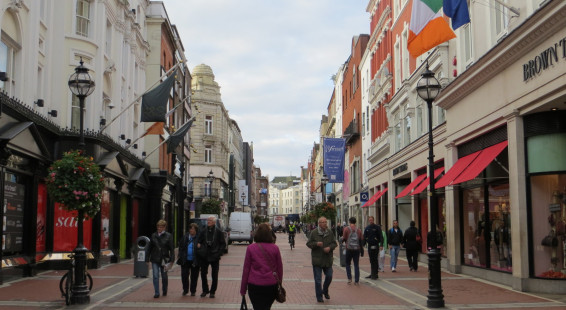
I remember being in Wales several times and looking across the sea to the west, thinking that I needed to get to Ireland. Well, I finally made it, completing this journey with my brother on our annual “getaway trip”! It was a trip we really enjoyed. This is the first in a series of blog posts about the Emerald Isle, focusing on some of its rich history and providing some observations on the country and its charming citizens.
Ireland’s history is a turbulent one and its people have had to endure many hardships for centuries. Victims of a devastating famine in the 19th century (the Great Hunger), occupied for almost a thousand years by foreigners (the Vikings and then the English), it’s only in the past century that the Irish have enjoyed self-rule. And this period of independence was plagued with significant sectarian violence, especially in the North, between “Republicans” (who favor Irish rule) and “Unionists” (who favor British rule). This civil disagreement is especially an important topic when discussing Northern Ireland, which I’ll do in a future blog post. The good news is that during the past two decades most of these domestic issues have resolved themselves to the point where they won’t interfere with any visitor’s plans to see the island. Today Ireland is slowly recovering from the bursting of its “Celtic Tiger” economic boom, and besides economic problems is having to deal with a large influx of immigrants, especially from Eastern European countries.
So why bother visiting Ireland? It’s a small country, not larger than most US states, and it has no grand mountains (although some memorable scenery). Its weather is typically wet and cold. It’s the most deforested nation in the European Union. So what does Ireland offer a visitor? Quite simply Ireland’s greatest asset is its people, their music, and relics of their interesting history. You’ll find yourself constantly charmed by the Irish, who are educated, engaging, witty and spunky. They enjoy people and conversation, so never be shy about approaching someone and asking a question. The Irish are as curious and interested in you and where you’re from as you are in them.
The Irish are blessed (or cursed, depending on your perspective) with the “Gift of Gab” — they just l-o-v-e to chat and do so in a most entertaining way. Oral traditions started here with ancient Celts, when laws and folklore were spoken and handed down from generation to generation (before a written language was developed). The Irish have their own language, Gaelic, but only about 5% of people still speak it and most of those folks are in the far western part of the country.
The Irish have a wonderful musical tradition and a genuine love of music, especially of sad songs. You’ll hear these sung frequently on street corners but especially in pubs where Irish music thrives and is actually growing in popularity especially amongst the young, something I find heartening. So as part of any visit you’ll want to spend some time in the pubs even if you’re a teetotaler, because it’s here you’ll get to know the local Irish people best, easily have conversations with them and also have the chance to enjoy their music and songs. The Pubs are centers of social life in Ireland and are much more than a place to have a drink (although the Irish are proud of their beer — Guinness (dark stout), Smithwicks (amber ale) and Harp (golden lager) — and enjoy their triple distilled whiskey). Pubs are a fun place to relax and listen to music, to people watch and to enjoy tasty and reasonably priced food. Irish food, like English food, has greatly improved in the past decades and certainly has moved away from a potato based diet.
A few other interesting tidbits about Ireland and the Irish:
- Ireland was never conquered by the Roman empire.
- It has thousands of old stone circles and relics of stone forts and buildings, many dating back to the early days of Christianity. Being built of stone, many are well preserved and fascinating to visit.
- Christianity came early to Ireland and took hold during the time of St. Patrick. Did you know that Irish monks keep writing and literature alive during the Dark Ages and later re-introduced it to the European continent? You can still see some of the wonderfully crafted books from the Dark Ages, like the Book of Kells at Trinity College in Dublin, arguable the greatest work of art of its time.
- Before the great potato famine there were 8,000,000 residents in Ireland. The country never recovered from the death and emigration this famine caused and today it has only 4.5 million people (not counting Northern Ireland). But it’s now a land for immigrants, rather than a country from which they leave, as hundreds of thousands of Eastern Europeans and other people have moved here.
- Those many immigrants Ireland shared with the rest of the world had an disproportionate influence given their numbers, as many people of Irish descent rose to be Presidents, Prime Ministers and prominent leaders, especially in the USA and Canada.
- Just as with their political influence, the Irish have had a disproportionate influence on the arts, especially in the fields of writing and acting.
- Dublin is as far north as most Canadian cities but because of the Gulf Stream has a fairly mild climate.
- The Republic of Ireland has a Corporate tax law only 12.5% (as opposed to USA’s 35%).
So that’s a brief overview which hopefully will set the background for next posts which focus on Irish travel destinations.
(Click on thumbnails to enlarge, right arrow to advance the slideshow).

































2 Responses to A Visit to Ireland: Part 1) An overview of the Country and its People